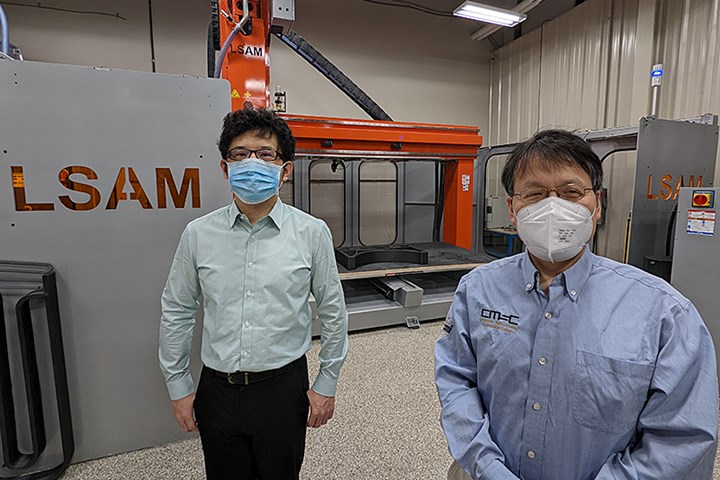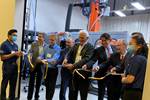AnalySwift, Purdue conduct research on design tool for tailorable composites use in space
Development and testing of the novel design tool will help industry exploit the potential of tailorable composites for designing better lightweight structures in space and on the ground.

Liang Zhang of AnalySwift (left) and Wenbin Yu of Purdue’s College of Engineering stand in front of large-scale additive manufacturing equipment in Purdue’s Composites Manufacturing and Simulation Center. Photo Credit: Wenbin Yu
Achieving affordable space exploration will require lightweight composite structures for vehicles, solar arrays and antennas. Lightweight materials will also be used for components of structures like , cryogenic tanks, landing gear and truss cages. (West Lafayette, Ind., U.S.) a Purdue University-affiliated commercial software provider, and Wenbin Yu, a professor in Purdue’s , are conducting research to create a design tool to help fully exploit tailorable composite materials’ full potential for these kinds of applications. Yu is the principal investigator. Liang Zhang of AnalySwift and Xin Liu of the University of Texas (Arlington) are co-investigators.
Allan Wood, AnalySwift president and CEO, says that existing design tools were developed for traditional composites, which have straight fibers. If an open area is needed inside a traditional composite structure, this is often accomplished by creating a cut-out after it is manufactured, which can compromise the integrity of the structure.
“Tailorable composites, also known as tow-steered or variable thickness composites, however, can be highly customized thanks to improvements in manufacturing,” Wood notes. “New robotic techniques can weave fibers around areas intended for openings, expanding design options while improving the structures’ overall properties.”
AnalySwift has received a one-year, $125,000 Phase I Small Business Technology Transfer (STTR) from the National Aeronautics and Space Administration (Washington, D.C., U.S.) for a project titled “An Efficient, High-Fidelity Design Tool for Advanced Tailorable Composites.” Yu says the project will benefit NASA and related agencies and industries by exploiting the potential of tailorable composites for designing better lightweight structures.
“The resulting efficient, high-fidelity design tool developed in this project will shorten the design and analysis period of structures made of tailorable composites,” Yu claims.
Wood says the design tool will have applications on Earth as well as in space, including aerospace, energy and wind, automotive, marine and other industries. “The tool could also lead to improve designs for high-performance, tailorable structures like prosthetics, electronics and sporting goods with reduced design cost and time,” he concludes.
Related Content
-
Partners recycle A350 composite production waste into adjustable-length rods for MFFD
Herone, Spiral RTC, Teijin Carbon Europe and Collins Aerospace Almere recycle A350 thermoplastic composite clips/cleats waste into rods for the all-thermoplastic composite Multifunctional Fuselage Demonstrator’s crown.
-
Syensqo composites demonstrate titanium replacement on Boeing MQ-25 Stingray
Validation of integrating Cycom 5250-4HT prepreg into the UAV’s exhaust nozzle structure underpins the material system’s use in other high-temperature aerospace applications.
-
ECOHYDRO project to enable recyclable composites for hydrogen storage
With the involvement of two schools from the Institut Mines-Télécom, the 4-year project aims to improve the intrinsic properties of a composite material based on Elium via four concrete demonstrators.






